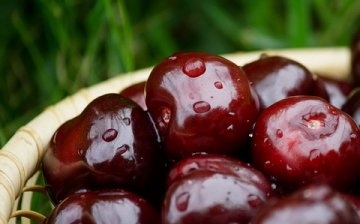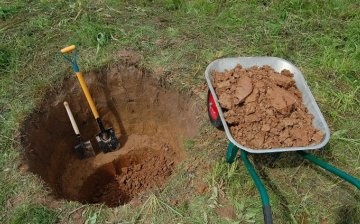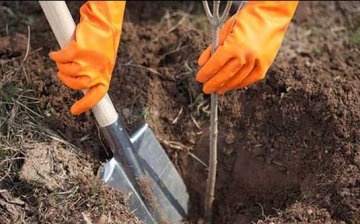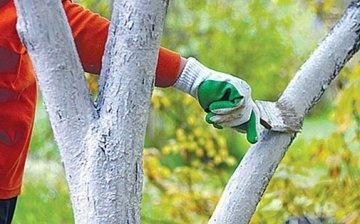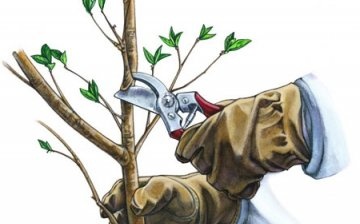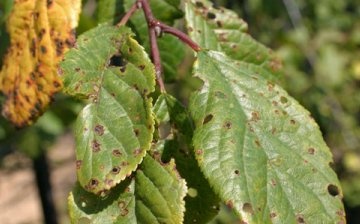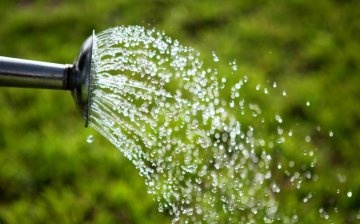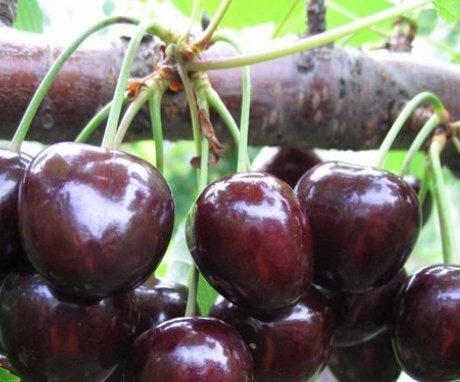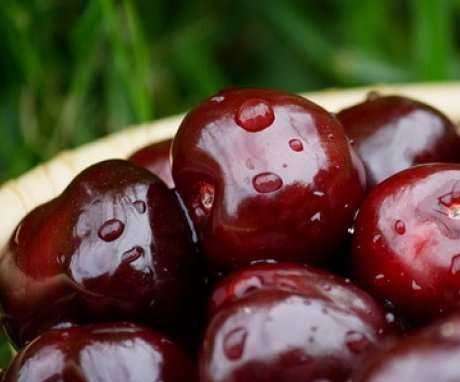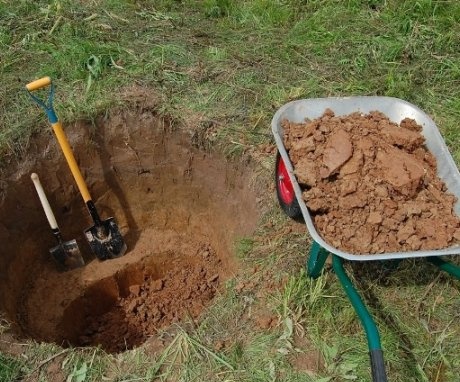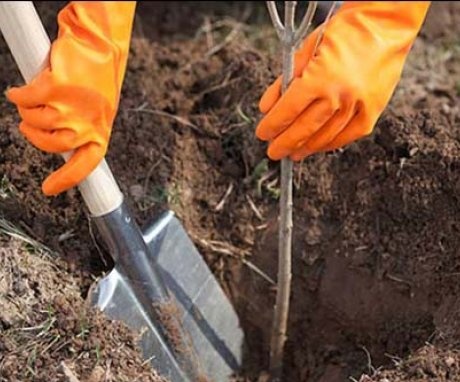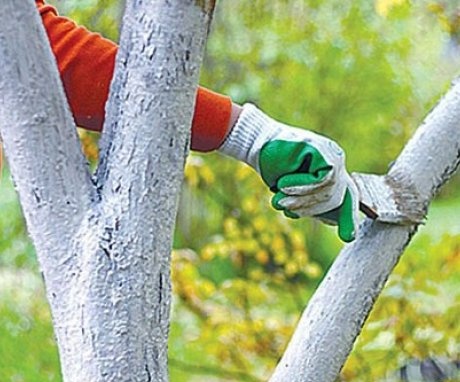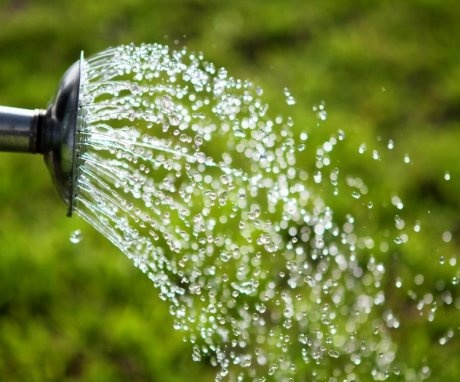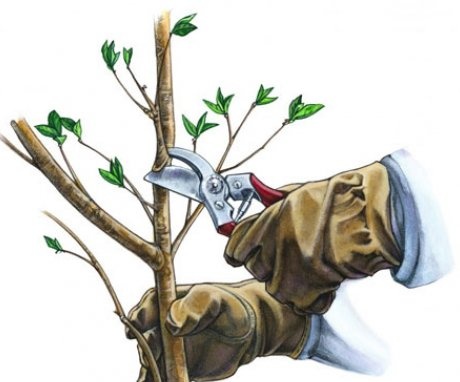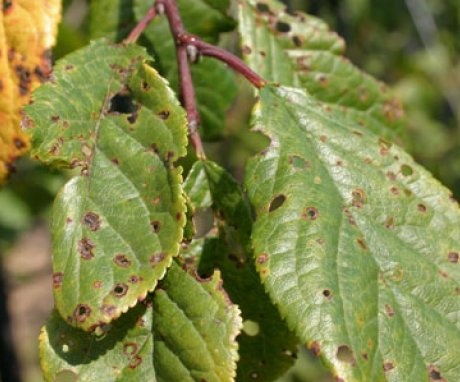Cherry Leningradskaya black - a great option for your garden
Sweet cherry - one of the few cultivated plants that appeared before our era (in Greece, after which it was delivered to Europe and further around the world). Initially, it is a heat-loving plant, not frost-resistant. But just over 100 years ago, the Leningradskaya Black variety was bred at the Pavlovsk Experimental Breeding Station, which will be discussed in this article.
Content:
- General description of fruit and tree
- Useful properties of cherries
- Site requirements
- Planting cherries: a step-by-step description
- Cherry care
- Pruning young shoots
- Pests and diseases
General description of fruit and tree
The main differences of this variety are its increased (although not high compared to other plants) resistance to temperature extremes, a low trunk, convenient for picking berries and quite large yield.
Features of the cherry variety:
- Size, weight of the fruit - large, up to 5 grams.
- Fruit color - burgundy, turning into black
- Fruit shape - heart-shaped
- Ripening period - July 15-July 20
- Productivity per tree - 30-40 kg
- Barrel height - 3-4 m
- Pollinators - other varieties of cherries (Veda, Michurinka, Tyutchevka, Leningrad red / pink, Revna) and cherries.
- Susceptibility to disease and pest attacks - Low
As you can see, the Leningrad black cherry is not capable of self-pollination, therefore it is better to plant it in tandem with another variety or at all cherry, which also has a beneficial effect on the quantity and characteristics of the crop.
It ripens, by the way, not evenly, so the berries ripened on July 15-16 can safely sag in "waiting" for ripening fruits until the beginning of September, without losing a single gram in weight and taste.
This cherry variety is rightfully considered one of the most promising for cultivation in warm and cool regions.
Therefore, it can be found almost everywhere. And, most likely, it will be perfect for you! The range of using the berries of the Leningrad black cherry is quite wide - juices, preserves, compotes and just freezing. It is also possible to use in the preparation of wine and various medicinal tinctures.
Useful properties of cherries
In addition to excellent taste, berries this variety has a fairly impressive list of useful medicinal and prophylactic properties.
Namely:
- Positive effect on blood composition and vascular condition. Increases the level of hemoglobin, thins the blood, strengthens and thickens the walls of blood vessels.
- Improves the condition and function of the heart, normalizes blood pressure.
- Facilitates and improves the functioning of the central nervous system: Can be used to treat neuroses, stimulate brain activity (treatment of atherosclerosis).
- Improves the functioning of the kidneys, gastrointestinal tract.
- It has a positive effect on the joints.
All these properties cherries have acquired due to their rich natural composition: vitamins of groups A, B, E, PP; ascorbic and malic acids; carotene; flavanoids; pectin; many useful micro and macro elements.
Due to the rather high sugar content, the berries of this variety are not recommended for diabetics, at least in large quantities. In other cases, there are no contraindications, only positive properties. Therefore, we can say that the Leningrad black cherry is a "golden" product!
Site requirements
As sweet cherry - the plant is thermophilic, the site for planting the seedling should be an area open to sunlight. If you plant a tree in the shade, the trunk will stretch out, the sugar content of the fruit will decrease, and the overall yield will also suffer.
To save the tree from strong winds and cold winters, you can choose a place next to a brick building that will cover the cherry on the north side.
The soil in which the tree is planted should be light, preferably medium sandy loam or loamy with the most neutral acid-base index (pH = 6.8 - 7.0).
Groundwater level: 1.5-2 meters. There should be no accumulation of moisture, since the plant does not tolerate this and may die. It is recommended to plant cherries on a hill or on level soil, but not in a lowland, where it can be flooded. In general, the ideal place for planting Leningrad black cherries is a flat, free, illuminated area of fertile, ventilated soil. This will certainly be found in every gardener!
Planting cherries: a step-by-step description
For maximum effect, the landing site must be chosen in the fall. Since ideal conditions are pre-dug and fertilized soil, in which the humus lay for the winter and managed to finally decompose. Superphosphates (0.5 kg) and about 100 grams of sodium sulfate are added to such a hole in the spring. By mixing this mixture with humus at the bottom of the pit, you complete the work on preparing the site for planting.
Recommendations for planting a seedling:
- As a standard, a hole is dug in the fall with a depth of about half a meter and a width of about 80 cm.
- Now you need to deal with sapling: twigs, if they started to grow, can be pruned initially. Touch good root system not worth it. Only in the presence of dry roots, the dried up part can be cut off and the tree can be placed in water for 10 hours for renewal.
- After that, the seedling is removed from the water and installed in an already prepared hole so that the neck of the tree trunk is at an elevation above the soil of about 5-7 cm. In the future, the earth will settle, and the levels will be equal. In the case of the initial concealment of the neck under the ground, the cherry may die.
- After the trunk is installed in the pit, it is necessary to form a small depression around it with a shovel and pour 1 bucket of water evenly.
- Then peat mulch is laid out on the same place (if there is no peat, you can use humus). This concludes the planting process!
It is also necessary to remember that the distance between the trees should not be less than 3 meters and it is better to plant different varieties nearby (for good pollination.
As for the planting time, the seedlings should be planted exclusively in the spring.
The feeding area of each young sweet cherry is 12 m2. Knowing all the above "secrets" and following exactly the recommendations, you can easily cope with planting the Leningrad black cherry!
Cherry care
Process leaving behind a planted tree can be divided into work related to the ground and with the trunk and crown of the tree itself. If we talk about land work, then in them two main directions can be distinguished: fertilization and watering, as well as additional - weeding.
Fertilizer for cherries:
- Initially, you need to know how rich the soil itself is in minerals. Since it is often not worth feeding rich lands, while resource-poor soils need to be "fed" not once, but annually.
- But overdoing it is also not worth it, since an excessive amount fertilizers can provoke the rapid growth of new shoots and inhibition of processes preparing for winter: the tree simply will not gain in the thickness of the branches and trunk, build up the bark. And this can lead not only to the death of all immature branches, but also to the death of the entire tree.
- The perfect combination is a combination mineral and organic fertilizers in small quantities to fill the existing deficiencies in the soil.
- Usually, it is recommended to complete fertilization by the end of spring, and digging with the addition of mineral fertilizers to be carried out until the end of September, so as not to provoke a new round of rapid growth before frost, which we have already mentioned.
- In autumn feed cherries are better with phosphorus-containing dressings, which strengthen the plant's resistance to frost.
- Also, once every three years, you can dig up the near-stem soil with the addition of eight kilograms of fermented organic fertilizers (manure or chicken droppings). Fresh material will not suit unambiguously, since fermentation takes a certain time, and cherries need nutrients immediately after digging.
- It is also worth remembering that nitrogenous fertilizers can only be added in the spring and never in the fall. The best option is to add liquid nitrogen solutions to the tree's "diet" around mid-spring. But it is better to add "green" fertilizers in the fall: first, at the beginning of summer, peas, sainfoin or mustard are sown, after which they are mowed (in September) and added to the peri-stem circle cherries.
Leningrad black cherry itself is prone to the formation of basal shoots, which may seem promising, but in fact do more harm than good, since they consume a significant proportion of the available nutrients, giving practically no substitutes harvest... Therefore, such branches should be cut off immediately, without fear and without hesitation.
As for glaze, then you also need to be guided by the condition of the soil:
- If the ground is already dry at a depth of 40 centimeters, or, on the contrary, is too wet, then it is worth making changes to the irrigation schedule.
- General recommendations are that you need to water the tree after the end flowering and up to the "final" stage of ripening, especially abundant in May - June (5 times a month, 2 times a day, 1 bucket per 1 tree).
- It is not worth watering the cherries later, as this can lead to "oversaturation" and rupture of the fruit. Watering produced only when the summer is clearly dry and there is not enough moisture in the soil.
- During the last watering, the water should be warm enough (about 25 C) to slow down the speed of the sap and prepare the tree for winter.
- The last and most voluminous watering is carried out during the autumn digging. Each tree uses 50 liters of heated water, and mulch is laid out on top, which helps to retain moisture.
- The next watering is carried out only in the new spring, before the tree blooms (otherwise it may lose all color). Weeding, especially of young trees, is carried out carefully as needed.
It is also necessary to mention several ways of caring for the tree itself:
- "Pre-winter" pruning crowns - can significantly increase the tree's resistance to frost if a cold winter is expected. It is necessary to shorten the shoots, as a result of which the leaf plates will increase.
- Whitewashing the trunk and branches - will help to avoid sunburn caused by temperature changes during the day and at night. For young trees, a chalk solution is used, and for older trees, a lime solution. It works like a mirror, reflecting the sun's rays and protecting the barrel from overheating. The consistency of the finished solution should resemble sour cream in viscosity in order to tightly cover the entire surface of the bark.
- Making an insulating "fur coat" - from paper or pine branches, roofing felts, will help how to protect the tree from sunburn, and protect it from the effects of cold air. The only rule and warning is not to use "grass coats", both green and dry (straw). Since they will not protect the tree, but rather attract pests.
- Cutting off flowers in the first year of flowering is done in order to preserve the "strength" of the plant and better survival rate. All or almost all flowers are plucked.Although it is not so easy to do from an emotional point of view, this process is very important, since otherwise the tree may simply not survive the winter or give the first good harvest only for 5 years of flowering.
Summarizing all of the above, we can conclude that the Leningrad black cherry requires sufficient attention to itself. But the process of leaving itself is not that difficult. Therefore, it is only important not to deviate from the instructions and to carry out all the work in a timely manner.
Pruning young shoots
Very important in the question crown formation... Carried out in the first 5 years of life cherries, then stops as unnecessary. The technology itself is quite simple: shoots / branches are selected that grow at an angle of 45-50 degrees - they will make up the crown. Approximately 1/5 of their length is cut off. All other young shoots are cut directly on the trunk without the formation of stumps, especially those that are directed vertically upwards or even towards the trunk. Branches that have accumulated densely in one place are also removed. We need a spreading and spacious crown.
Important! Do not remove more than ¼ of the total number of branches / shoots at a time, as this will be very stressful for the tree.
Also, don't prune branches in the fall. The main pruning period is spring (before the first buds appear). Pruning in mid-August is also possible when strong growth is evident.
After the fifth year flowering this process stops, and only sanitary cleaning of the tree from dry and drying branches remains. Do not miss the moment at the very beginning, prune regularly, and you will have an excellent, beautiful and, most importantly, fruitful crown of the tree!
Pests and diseases
As mentioned at the beginning of the article, the Leningrad black cherry is weakly exposed to pests and diseases.
Cherry pests:
- The main enemies of the tree are birds, which can destroy almost the entire crop in an hour. To eliminate this threat, special networks covering the crown are used. They have proven themselves better than any other "folk" methods of scaring off, because they are able to save almost everything berries.
- Also for cherries rodents are to some extent dangerous, from which special nets also protect.
If we talk about diseases, then Leningrad Black is sick only in unfavorable conditions, for example, with high air humidity (from rain and fog). But in any case, standard sets of fungicides and insecticides (from aphids), as well as the removal of affected branches and shoots, are excellent for curing a tree.
The sweet cherry variety can be called a fairly healthy plant with a strong "immunity", which is easy to maintain in excellent condition.
Looking at the description of the whole Leningrad black cherry, we can say that this is an excellent variety, both for beginners and experienced gardeners, which is not so difficult to care for, and harvest from which it is very easy and pleasant to collect.
By following the above tips and instructions, you will easily understand the principle of growing trees of this variety and can even set up your own small garden! The main thing to remember is that the Leningrad black cherry is a paired plant that requires "neighbors" of a different variety.
More information can be found in the video.





